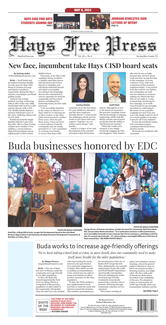By Andy Sevilla
For Victor Tepetate, a little help goes a long way.
During the summer months, every Monday through Friday, Tepetate, his wife and four children wait outside the Regency Mobile Home Park in San Marcos during lunchtime for a free meal.
That meal helps his children get through the day, Tepetate said.
“These days work is slow,” he told the Hays Free Press in Spanish, his native language, as he waited for his children to finish eating. “There are days when it’s difficult. This is of great help.”
The San Marcos CISD Child Nutrition Department has for years provided district children free meals for breakfast and lunch at school campuses during the summer months when school is out. In 2012, the district’s summer feeding program took to the streets and wheeled in healthy foods to children at neighborhoods and community sites where the need is great.
According to Mike Boone, Associate Director of Child Nutrition at SMCID, the summer feeding program allows many children to eat a hot meal they otherwise may not have had.
“They’re hungry in the summer,” Boone said. “We feed them all school year, but it doesn’t mean they turn their bellies off (when school’s out).”
And the kids that eat: they behave better, it’s healthier, they’re going to grow up with a nutritious meal — a lot better than Mickey Ds double-cheese for 99 cents — in their bellies.”
When the Hays Free Press visited the mobile meals bus (the summer feeding program’s method to wheel meals to children) kids of all ages, from one-year-old to high school students, took part in the program. They were fed whole-wheat, whole-grain pizza with reduced fat, low-sodium cheese, fresh carrots and watermelon, a side salad and steamed broccoli.
“It’s expensive to eat healthy,” Boone said. “… That stuff is expensive if you buy it at the store. It’s a lot cheaper if you go (purchase) a 99-cent double cheeseburger.”
The summer feeding program is federally funded through the U.S. Department of Agriculture. Boone said the federal government reimburses the cost of every meal the school district serves.
Tepetate said the summer program is beneficial for the community — a community that has more than 35 percent of its residents below poverty level, according to the U.S. Census Bureau’s latest data available.
By comparison, Buda and Kyle have 7.5 percent and 8.1 percent of its residents below poverty level, respectively, according to the same data. Though notably, Buda’s and Kyle’s population are 44,000 and 23,000 residents behind San Marcos’, respectively, according to the most recent U.S. Census population numbers.
“It’s a little difficult at times,” Tepetate said. “Like I once told my wife, ‘it’s not just us, but other families too.’”
When they first tried the program, Tepetate said, not many families were taking advantage of it at the Regency Mobile Home Park, the site where his four children, ranging in age from one to 11-years-old, get on the purple mobile meals bus and eat their free lunch. Tepetate said he encouraged his family to go on in the bus and eat, hoping to motivate other needy families to take part.
“It’s a great benefit for other families, as it is for my family,” he said.
Tepetate is a restaurant cook at a local San Marcos establishment. He’s been there for 11 years, though he said the pay isn’t enough to cover all expenses and provide for his family like he would like to. His wife isn’t employed, and takes care of the household and the four kids.
Though he’s been in the U.S. for 17 years, 11 of them in San Marcos, he said employment options for him are scarce as he faces roadblocks due to his lack of education, lack of resources and continued inability to master the English language.
“I always say 90 percent of those kids that are in this situation — it wasn’t any of their doing — they were born into that situation,” Boone said. “It’s not their fault they don’t come from a family that can’t provide.”
Tepetate said that without the program, his family’s situation would be a lot more difficult.
“It’s a great benefit to us and we’re very grateful for it,” he said. “… We’re grateful for this resource and thankful that they don’t forget about us.”




